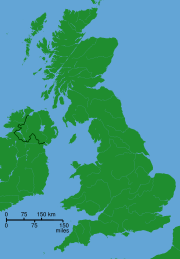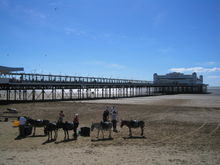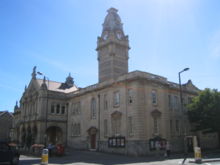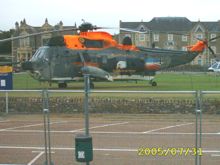Weston-super-Mare
2007 Schools Wikipedia Selection. Related subjects: Geography of Great Britain
| Weston-super-Mare | ||
|---|---|---|
|
|
||
| Statistics | ||
| Population: | 71,758 | |
| Ordnance Survey | ||
| OS grid reference: | ST324615 | |
| Administration | ||
| District: | North Somerset | |
| Region: | South West England | |
| Constituent country: | England | |
| Sovereign state: | United Kingdom | |
| Other | ||
| Ceremonial county: | Somerset | |
| Historic county: | Somerset | |
| Services | ||
| Police force: | Avon and Somerset Police | |
| Fire and rescue: | Avon | |
| Ambulance: | South Western | |
| Post office and telephone | ||
| Post town: | WESTON-SUPER-MARE | |
| Postal district: | BS22, BS23, BS24 | |
| Dialling code: | 01934 | |
| Politics | ||
| UK Parliament: | Weston-super-Mare | |
| European Parliament: | South West England | |
Weston-super-Mare is an English seaside resort town in North Somerset, population 71,758 ( 2001 Census). It is situated on the Bristol Channel approximately 18 miles (28 km) south west of Bristol. The town has spread along the coast between the bounding high ground of Worlebury Hill and Brean Down. It is well known for its sandy beaches, although at low tide the sea can be over a mile from the beachfront, and a substantial trek across the mud is necessary in order to reach the "sea". However, attempting to reach the sea at these times is inadvisable as the sand gives way to mud which is very deep and has cost several people their lives over the years. Driving on the beach catches people out as they drive too close to the sea and break through the sand to the underlying mud and are then stuck. Several cars get washed out to the sea every year. Weston-super-Mare is the most populous civil parish in England.
Weston comes from the Anglo-Saxon for the west tun or settlement. The descriptive part of its name is unusual because it is in medieval Latin and was first recorded by an unknown medieval church clerk, presumably to distinguish it from other Westons in the area. It is a popular myth that the description was a later Victorian invention. It means literally "on sea". It is pronounced mair rather than mahrey, however.
Early in the nineteenth century, Weston was a small windswept village of about 30 houses, located behind a line of sand dunes fronting the sea. The Pigott family of Brockley, who were the local Lords of the Manor, had a summer residence at Grove House. Weston owes its growth and prosperity to the Victorian era boom in seaside holidays. Construction of the first hotel in the village started in 1808, it was called the Royal Hotel. Along with nearby Burnham-on-Sea, Weston benefited from proximity to Bristol, Bath and South Wales.
Isambard Kingdom Brunel and his family lived in Weston, at Swiss Villa (eastern corner of Alexandra Parade and Swiss Road), for a number of months whilst he was supervising the construction of the Bristol & Exeter Railway in the area. With the opening of the railway, thousands of visitors came to the town from Bristol, The Midlands and further afield, on works outings and Bank Holidays. Also, many mining families came across the Bristol Channel from South Wales by paddle steamer. To cater for them, Birnbeck Pier was completed in 1867, offering in its heyday amusement arcades, tea rooms, funfair rides and a photographic studio. However, it now stands in a derelict state and is in danger of collapsing into the sea. It is still possible for visitors to marvel at the structure from behind the barbed wire.
Large areas of land were released for development from the 1850s onwards. Large detached villas, for the middle classes, were built on the southern slopes of Worlebury Hill. Semi-detached and terraced housing were built on the low 'moorland', behind the sea front. Many of these houses have now been turned into bedsits by their owners.
In 1885 the first transatlantic telegraph cable of the Commercial Cable Company was brought ashore and the company started a long association with the town, ending in 1962.
Local traders, unhappy that visitors were not coming as far as the centre of the town, began the construction of a new pier closer to the main streets. Opened in 1904, and known as the Grand Pier, it was originally planned to be 1.5 miles (2.4 km) long. It still stands in truncated form today, although amusements and cafes have replaced the original music-hall theatre it supported, with the present building dating from 1933. Further development occurred after World War I, with the Winter Gardens and Pavilion (1927), the Open Air Pool and an airfield all dating from the inter-war period. Art Deco influences can be seen in much of the town's architecture from this period.
During World War II many evacuees were accommodated in the town. Weston suffered several bombing raids, damaging parts of the town centre, particularly Orchard Street and Boulevard. War industries, such as aircraft and pump manufacture, were dispersed to the town. Many US troops were billeted in Weston. They and their equipment vanished practically overnight, with the run-up to D-Day.
Since the 1970s Weston has suffered a large decline in popularity, like virtually all British seaside resorts. The advent of cheap foreign holidays and the break-up of large industries like mining contributed, as working communities became less likely to holiday together. The town had become a centre of industries such as helicopter production. Road transport links were improved with the M5 motorway running close by, and the town now supports several light industries and distribution depots, and functions partly as a dormitory town for Bristol. Philip Harris Ltd moved their production unit to the town in the 1970s to join their biological supplies division, which moved from Sheffield in 1965. Some biological supplies work still continues under different owners. It is worth noting, though, that the two largest employers are the luminaries of the local council and the academicians of Weston College.
The tourist traffic has never completely vanished and Weston nowadays could be considered to be weathering hard times moderately well. It has a shopping centre, helicopter museum, a sea-life centre (currently called the SeaQuarium) and miniature railway. There is also a derelict pier to the north of the town, a derelict theatre, swimming pool and sauna on Knightstone Island, although this island is now under development as a luxury housing and cultural complex with many of the existing buildings being retained due to their listed status. There is also the derelict "Tropicana" leisure complex approximately halfway down the sea front. However this to will be subject to regeneration - with a private developer having been selected to take forward the re-development of the Tropicana. The new development entitled 'Life Station@Tropicana' will include a covered swimming pool, cinema and bowling complex.
The town as a whole has expanded its size considerably and at one time in the eighties was the fastest growing municipality in Europe. Building continues apace, though notably the fashionable South side of town towards Bleadon has avoided this. In times past, motorists have been prevented from driving through Bleadon by security men, was due to a bridge being replaced and to stop through traffic going down narrow roads .
A large "carrot" shaped sculpture entitled 'The Silica' has been installed in the town centre recently to symbolise man's harmony with the sea. This was part of North Somerset Council's ongoing civic pride initiative that has sought to revitalise Weston-super-Mare's public spaces - which had suffered a period of decline. Other public space improvments have been made throughout the town such as improvements to the street scene in Grove Park Village. There has been some controversy in the town over whether the silica enhanced the town or was a waste of money. However, this debate centred round a misunderstanding of the government funds used to pay for the sculpture. Many local residents did not realise that the money came from central government and had to be used on public art/improvements to the street scene environment. Consequently there calls for the money to be re-directed to other public services could not be acted upon by North Somerset Council without the funding being withdrawn by central government.
The T4 on the beach music event is a recent addition, where well known bands and singers perform up to three of their hits, all aspects bar the vocals being mimed. International HeliDays is usually staged at the Beach Gardens over a long weekend around the end of July, where helicopters from around the world are displayed, in association with the Helicopter Museum. It is essential not to forget the Enduro, which attracts thousands of bikes, nor the Carnival, whose brightly illuminated floats light up the streets as winter approaches.
Residential areas include Oldmixon and the Bourneville estate, which exhibit many fine examples of post war and late twentieth century architecture. The Coronation Estate, with its streets imaginatively named after places the royal couple visited following the coronation, continues to earn its soubriquet, the 'Nowa Huta' of the West. Antisocial behaviour on this estate and on the Bovril, as it is locally known, is generally ignored by the town fathers. The indiscriminate placing of pylons is sometimes blamed for the physical peculiarities of people from this area.
Made an urban district in 1894, Weston-super-Mare became a municipal borough in 1937. In 1974, under the Local Government Act 1972, it was merged into the Woodspring district of the County of Avon, and became a Charter Trustees town. When Avon was split up in 1996, it became the administrative headquarters of North Somerset, one of the successor authorities. Weston-super-Mare regained a town council in 2000, becoming a civil parish. Politics is dominated by small cliques of ambitious activists, and carpetbaggers are occasionally parachuted in by the main parties. Local political life languishes, though, and public opinion is represented by the serried trivialities of the Weston Mercury, based on the Boulevard. There are those who maintain that Weston should be categorised as an anarcho-syndicalist commune, in the light of the paucity of policing.
Well-known former residents of the town include author, politician and supporter of women's rights Jeffrey Archer, guitarist Ritchie Blackmore, actor John Cleese, actress Mandy Miller, author Roald Dahl, journalist Jill Dando and actor Rupert Graves. The writer Bill Bryson had a wet time visiting, recounted in Notes from a Small Island. Arthur Stanley Eddington, one of the foremost astrophysicists of the early twentieth century grew up in the town. Attlee's Minister of Defence, A.V. Alexander was also raised in Weston-super-Mare. All of these pale into othing in comparison with Jill Dando.
In the Little Britain television series, the character Vicky Pollard claims to have seen the pop group Blazin' Squad in Weston-super-Mare.
The town's motto is "Ever Forward". It is twinned with Hildesheim which is in Germany. As the vast majority of inhabitants of Weston are old enough to remember the Blitz, the cordiality of relations is not without its limits.
The upper part of the beach is sandy but, as the sea retreats a long way with the tide exposing mud flats, the town is sometimes unkindly known as "Weston-super-Mud". The tidal range in this part of the Severn Estuary is one of the largest in the world and the beach / mud flats are on a gentle slope. Consequently it is only at the part of the tide cycle where high tide is in the early morning and late afternoon that the sea comes well up the beach. Many day visitors see little of the sea because of this and also must be confused to see a long pier with little or no water under it.
The tidal rise and fall is often said to be the second largest in the world after the Bay of Fundy in Canada and can be as great as 13 m (42 feet). ( Ungava Bay has recently been found to have a tidal range greater than the Severn.) This tidal movement contributes to the deposition of mud from the River Severn in bays such as the one at Weston. Chemically the channel is reasonably clean.
The town's local football team is Weston Super Mare Football Club.



